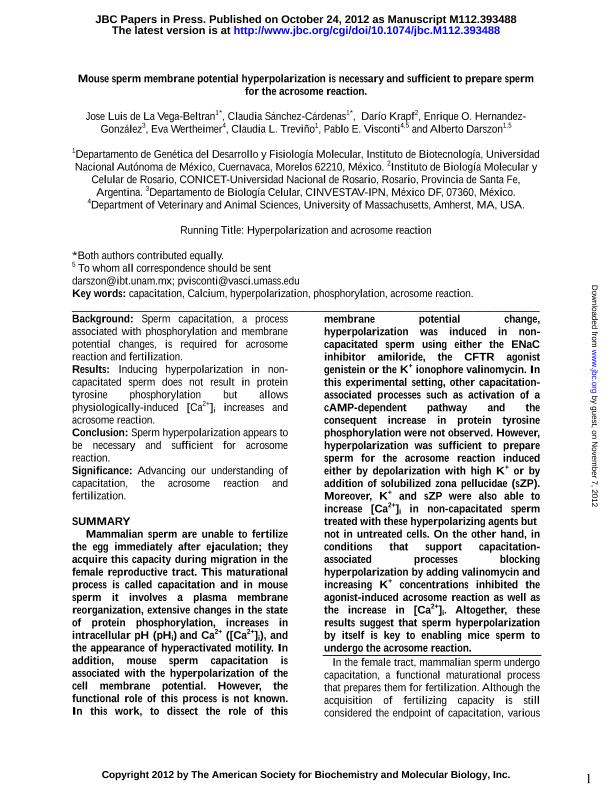Mostrar el registro sencillo del ítem
dc.contributor.author
de La Vega Beltrán, José Luis
dc.contributor.author
Sánchez Cárdenas, Claudia
dc.contributor.author
Krapf, Dario

dc.contributor.author
Hernández González, Enrique
dc.contributor.author
Wertheimer Hermitte, Eva Victoria

dc.contributor.author
Trevinio, Claudia L.
dc.contributor.author
Visconti, Pablo E.
dc.contributor.author
Darszon, Alberto
dc.date.available
2017-07-12T20:51:33Z
dc.date.issued
2012-12
dc.identifier.citation
de La Vega Beltrán, José Luis; Sánchez Cárdenas, Claudia; Krapf, Dario; Hernández González, Enrique; Wertheimer Hermitte, Eva Victoria; et al.; Mouse sperm membrane potential hyperpolarization is necessary and sufficient to prepare sperm for the acrosome reaction; American Society for Biochemistry and Molecular Biology; Journal of Biological Chemistry; 287; 53; 12-2012; 44384-44393
dc.identifier.issn
0021-9258
dc.identifier.uri
http://hdl.handle.net/11336/20286
dc.description.abstract
Mammalian sperm are unable to fertilize the egg immediately after ejaculation; they acquire this capacity during migration in the female reproductive tract. This maturational process is called capacitation and in mouse sperm it involves a plasma membrane reorganization, extensive changes in the state of protein phosphorylation, increases in intracellular pH (pHi) and Ca2+ ([Ca2+]i), and the appearance of hyperactivated motility. In addition, mouse sperm capacitation is associated with the hyperpolarization of the cell membrane potential. However, the functional role of this process is not known. In this work, to dissect the role of this membrane potential change, hyperpolarization was induced in noncapacitated sperm using either the ENaC inhibitor amiloride, the CFTR agonist genistein or the K+ ionophore valinomycin. In this experimental setting, other capacitation-associated processes such as activation of a cAMP-dependent pathway and the consequent increase in protein tyrosine phosphorylation were not observed. However, hyperpolarization was sufficient to prepare sperm for the acrosome reaction induced either by depolarization with high K+ or by addition of solubilized zona pellucida (sZP). Moreover, K+ and sZP were also able to increase [Ca2+]i in non-capacitated sperm treated with these hyperpolarizing agents but not in untreated cells. On the other hand, in conditions that support capacitation-associated processes blocking hyperpolarization by adding valinomycin and increasing K+ concentrations inhibited the agonist-induced acrosome reaction as well as the increase in [Ca2+]i. Altogether, these results suggest that sperm hyperpolarization by itself is key to enabling mice sperm to undergo the acrosome reaction.
dc.format
application/pdf
dc.language.iso
eng
dc.publisher
American Society for Biochemistry and Molecular Biology

dc.rights
info:eu-repo/semantics/openAccess
dc.rights.uri
https://creativecommons.org/licenses/by-nc-sa/2.5/ar/
dc.subject
Calcium Imaging
dc.subject
Fertilization
dc.subject
Ion Channels
dc.subject
Phosphorylation
dc.subject
Sperm
dc.subject
Acrosome Reaction
dc.subject
Calcium
dc.subject
Hyperpolarization
dc.subject
Sperm Capacitation
dc.subject.classification
Biología Reproductiva

dc.subject.classification
Ciencias Biológicas

dc.subject.classification
CIENCIAS NATURALES Y EXACTAS

dc.subject.classification
Bioquímica y Biología Molecular

dc.subject.classification
Medicina Básica

dc.subject.classification
CIENCIAS MÉDICAS Y DE LA SALUD

dc.subject.classification
Fisiología

dc.subject.classification
Medicina Básica

dc.subject.classification
CIENCIAS MÉDICAS Y DE LA SALUD

dc.title
Mouse sperm membrane potential hyperpolarization is necessary and sufficient to prepare sperm for the acrosome reaction
dc.type
info:eu-repo/semantics/article
dc.type
info:ar-repo/semantics/artículo
dc.type
info:eu-repo/semantics/publishedVersion
dc.date.updated
2017-07-12T13:19:02Z
dc.journal.volume
287
dc.journal.number
53
dc.journal.pagination
44384-44393
dc.journal.pais
Estados Unidos

dc.journal.ciudad
Bethesda
dc.description.fil
Fil: de La Vega Beltrán, José Luis. Universidad Nacional Autónoma de México. Instituto de Biotecnología; México
dc.description.fil
Fil: Sánchez Cárdenas, Claudia. Universidad Nacional Autónoma de México. Instituto de Biotecnología; México
dc.description.fil
Fil: Krapf, Dario. Consejo Nacional de Investigaciones Científicas y Técnicas. Centro Científico Tecnológico Conicet - Rosario. Instituto de Biología Molecular y Celular de Rosario. Universidad Nacional de Rosario. Facultad de Ciencias Bioquímicas y Farmacéuticas. Instituto de Biología Molecular y Celular de Rosario; Argentina
dc.description.fil
Fil: Hernández González, Enrique. Instituto Politécnico Nacional. Centro de Investigación y de Estudios Avanzados; México
dc.description.fil
Fil: Wertheimer Hermitte, Eva Victoria. University of Massachussets; Estados Unidos
dc.description.fil
Fil: Trevinio, Claudia L.. Universidad Nacional Autónoma de México. Instituto de Biotecnología; México
dc.description.fil
Fil: Visconti, Pablo E.. University of Massachussets; Estados Unidos
dc.description.fil
Fil: Darszon, Alberto. Universidad Nacional Autónoma de México. Instituto de Biotecnología; México
dc.journal.title
Journal of Biological Chemistry

dc.relation.alternativeid
info:eu-repo/semantics/altIdentifier/url/http://www.jbc.org/content/287/53/44384
dc.relation.alternativeid
info:eu-repo/semantics/altIdentifier/doi/http://dx.doi.org/10.1074/jbc.M112.393488
dc.relation.alternativeid
info:eu-repo/semantics/altIdentifier/url/https://www.ncbi.nlm.nih.gov/pmc/articles/PMC3531752/
Archivos asociados
